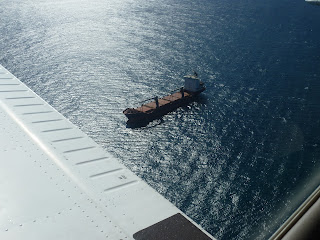Since the last update there have been developments both in the air and on the ground.
Firstly, and most importantly, the final ATPL results arrived last week and I'm happy to say all have been satisfactorily complete with the needed percentage gained.
The exams have been a long, drawn out process and something I feel quite proud to have complete. They're not for the faint hearted and although I feel they hold an undeserved prestige of being difficult I do believe that they are the result of someone's extreme hard work and dedication.
I remember travelling to the Annex on our first day of ATPLs and a now friend said, as he was to begin his final module, that the six months following would be the quickest we would ever experience - I cannot emphasis how true those words were.
They're the largest and most feared part of the training - something I am glad to never have to see again!
Having said goodbye to the family last week we were half way through out CPL ground school training. This course is designed as both a refresher and an introduction into flying a twin-engined aircraft under the JAA system.
During the five days of ground school we covered everything from engine failure on take-off to the phraseology that should be used in Europe (and supposedly across the world!) on the radios.
It was great to finally start to get to terms with a type of aircraft (twin) that I hope to be flying on a much greater scale in the near future.
The ground course was completed with an exam on Monday morning which I am happy to say everyone comfortably passed.
More importantly over the past week or so I've managed to complete a serious number of flights. The only remaining flight I now have is an internal check ride with one of the senior flight instructors at the weekend before beginning in the Seminole.
Over the past week or so I have been extremely lucky in terms of weather and aircraft availability. A lot of friends and colleagues here have been turned away time and time again due to a large number of aircraft being broken and the weather not being as they had hoped.
I however have managed to log eight flights, exactly twenty hours of flight time with twenty seven takeoff/landings. This excludes the time flying with the family and the majority of this was fitted around the ground school.
It has been extremely tiring and frustrating but I have had a fantastic time with it all the same and managed to visit some fantastic places as I'll now explain below.
After completing a couple of duals on Thursday and Friday last week early morning, I had two four hour cross country flights to complete at the weekend with each lasting over 300NM with one leg being at least 150NM in length.
On Saturday I was planning to head from Melbourne to Titusville (just north of here) and then down to Naples on the west coast. This would allow me to cover the 150NM required on the day's routes. From Naples I was going to head down to Tamiami, an airport near the world famous Miami where I would refuel before heading back up the coast past the city as the sun fell. That was the plan anyway.
Due to the aircraft arriving back late it cut down the amount of time I would have to complete the route. Therefore I made a quick modification. I changed my final stop from Tamiami to West Palm International. Although the route would be shorter it would still be in excess of 150NM.
After heading up to Titusville I headed towards Okeechobee, the old stomping ground. This would be the point I would pass over en route to Naples. Having made contact with Miami Approach I was soon passed over to Fort Myers Approach who gave me vectors towards Naples. The weather wasn't the best. It was getting quite turbulent and the clouds started to move in, although they did remain quite sparse throughout the trip. A touch and go in Naples followed by a departure to the East back to the Atlantic coast line.
The flight across the state to West Palm was quite interesting as I was only covering the ground at around 85kts (98mph) compared to the outbound leg of 136kts (157mph). This made the leg in to almost an hour sector.
Finally I arrived on the approach in to the airport.
"N369FT expect runway 10R, advise when you have Lima."
The approach plan was complete and the airport was in sight.
"West Palm Approach, N639FT has the airport in sight."
"N639FT, West Palm Approach, contact Tower on 119.100"
The weather had really cleared as the sun started to set in my six o'clock. I was very much looking forward to the flight back up the coast to Melbourne.
"N639FT contact departure, have a good day."
The journey back along the coast was fantastic. I managed to climb to 8,500ft as the sun began to set over the sunshine state. I was able to get some fantastic photos.
It was soon time to start the descent in to Melbourne after a fantastic day out flying. The sun was soon over the horizon and darkness fell.
"FIT 39, cleared to land Runway 5." Home.
More to follow this weekend including another four hour solo, a trip to the largest airport in the state and overflying the NASA airport at 100ft.




























